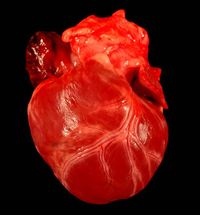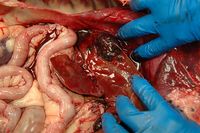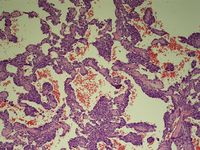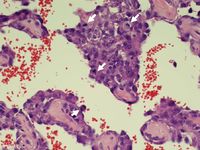Difference between revisions of "R(D)SVS VPU 01"
| Line 1: | Line 1: | ||
| − | |||
| − | |||
| − | Image: | + | [[Image:Gross Heart.jpg|thumb|right|200px|Gross heart with pericardium removed]] |
| + | You are presented with a case of a 9 year old, male neutered golden retriever. The dog had a history of sudden death. On gross examination the pericardial sac was full of blood. | ||
| + | [[Image:Liver pathology.jpg|thumb|right|200px|Masses in liver]] | ||
| + | Multifocal to coalescing, dark red, pinpoint to 5cm masses were also present throughout the liver. | ||
| + | <br> | ||
| + | [[Image:Low power.jpg|thumb|right|200px|Low power micrograph of mass]] | ||
| + | Microscopically, the mass is composed of multiple, variably-sized, irregular, blood-filled channels and spaces. | ||
| + | [[Image:High power.jpg|thumb|right|200px|High power micrograph of mass]] | ||
| + | On high power, these spaces channels are lined by plump, pleomorphic spindle cells which exhibit marked anisocytosis and anisokaryosis. The nuclei contain 1-2 dark basophilic nucleoli. Within this single high power field (400x), four mitotic figures are present (arrows). The cells are not arranged in an organised manner, instead they are ‘piled up’ on top of one another. | ||
| − | + | <WikiQuiz | |
| + | questionnumber="1" | ||
| + | question=" | ||
| − | + | Which of the following is the most likely diagnosis? | |
| + | " | ||
| + | choice5="Haemangiosarcoma" | ||
| + | choice1="Dilated cardiomyopathy" | ||
| + | choice4="Haematoma" | ||
| + | choice2="Hypertrophic cardiomyopathy" | ||
| + | choice3="Chemodectoma" | ||
| + | correctchoice="5" | ||
| + | feedback5="'''Correct!''' Cellular pleomorphism, anisocytosis, anisokaryosis, high mitotic index and lack of tissue organisation are all histological features of malignancy. The spindle shape of the neoplastic cell population is indicative of a malignant mesenchymal tumour i.e. a sarcoma. The formation of blood-filled channels and spaces is typical of a tumour of endothelial cells, which under normal circumstances are responsible for lining the internal surface of blood vessels. The diagnosis in this case is therefore haemangiosarcoma. [[Haemangiosarcoma|WikiVet Article: Haemangiosarcoma]] | ||
| + | " | ||
| + | feedback1="'''Incorrect.''' Cellular pleomorphism, anisocytosis, anisokaryosis, high mitotic index and lack of tissue organisation are all histological features of malignancy. The spindle shape of the neoplastic cell population is indicative of a malignant mesenchymal tumour i.e. a sarcoma. The formation of blood-filled channels and spaces is typical of a tumour of endothelial cells, which under normal circumstances are responsible for lining the internal surface of blood vessels. The diagnosis in this case is therefore haemangiosarcoma.[[Haemangiosarcoma|WikiVet Article: Haemangiosarcoma]] | ||
| + | " | ||
| + | feedback4="'''Incorrect.''' Cellular pleomorphism, anisocytosis, anisokaryosis, high mitotic index and lack of tissue organisation are all histological features of malignancy. The spindle shape of the neoplastic cell population is indicative of a malignant mesenchymal tumour i.e. a sarcoma. The formation of blood-filled channels and spaces is typical of a tumour of endothelial cells, which under normal circumstances are responsible for lining the internal surface of blood vessels. The diagnosis in this case is therefore haemangiosarcoma. [[Haemangiosarcoma|WikiVet Article: Haemangiosarcoma]] | ||
| + | " | ||
| + | feedback2="'''Incorrect.''' Cellular pleomorphism, anisocytosis, anisokaryosis, high mitotic index and lack of tissue organisation are all histological features of malignancy. The spindle shape of the neoplastic cell population is indicative of a malignant mesenchymal tumour i.e. a sarcoma. The formation of blood-filled channels and spaces is typical of a tumour of endothelial cells, which under normal circumstances are responsible for lining the internal surface of blood vessels. The diagnosis in this case is therefore haemangiosarcoma. [[Haemangiosarcoma|WikiVet Article: Haemangiosarcoma]] | ||
| + | " | ||
| + | feedback3="'''Incorrect.''' Cellular pleomorphism, anisocytosis, anisokaryosis, high mitotic index and lack of tissue organisation are all histological features of malignancy. The spindle shape of the neoplastic cell population is indicative of a malignant mesenchymal tumour i.e. a sarcoma. The formation of blood-filled channels and spaces is typical of a tumour of endothelial cells, which under normal circumstances are responsible for lining the internal surface of blood vessels. The diagnosis in this case is therefore haemangiosarcoma.[[Haemangiosarcoma|WikiVet Article: Haemangiosarcoma]] | ||
| + | " | ||
| + | image= ""> | ||
| + | </WikiQuiz> | ||
| − | + | [[Category:R(D)SVS VPU]] | |
| − | |||
| − | |||
| − | |||
| − | |||
Revision as of 15:22, 11 July 2011
You are presented with a case of a 9 year old, male neutered golden retriever. The dog had a history of sudden death. On gross examination the pericardial sac was full of blood.
Multifocal to coalescing, dark red, pinpoint to 5cm masses were also present throughout the liver.
Microscopically, the mass is composed of multiple, variably-sized, irregular, blood-filled channels and spaces.
On high power, these spaces channels are lined by plump, pleomorphic spindle cells which exhibit marked anisocytosis and anisokaryosis. The nuclei contain 1-2 dark basophilic nucleoli. Within this single high power field (400x), four mitotic figures are present (arrows). The cells are not arranged in an organised manner, instead they are ‘piled up’ on top of one another.
1 |
Which of the following is the most likely diagnosis? |



